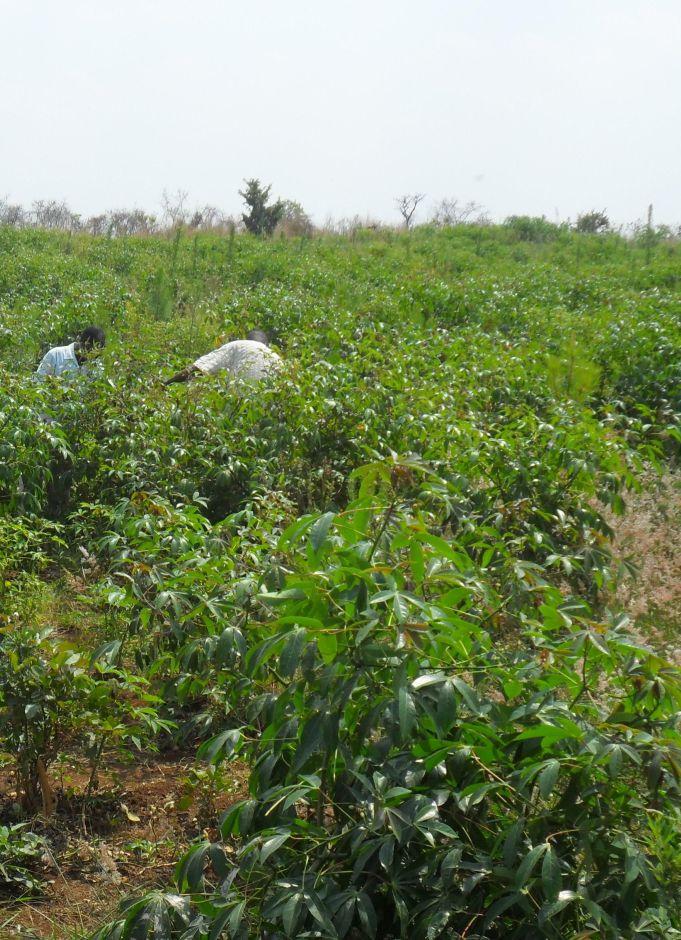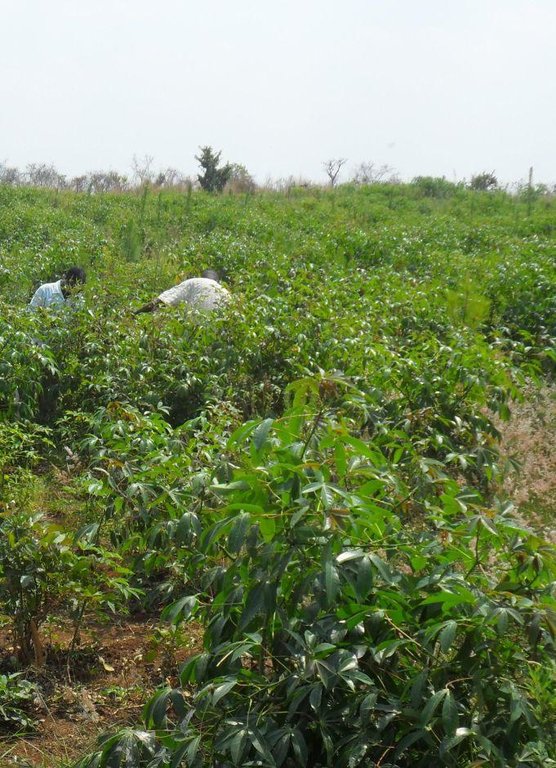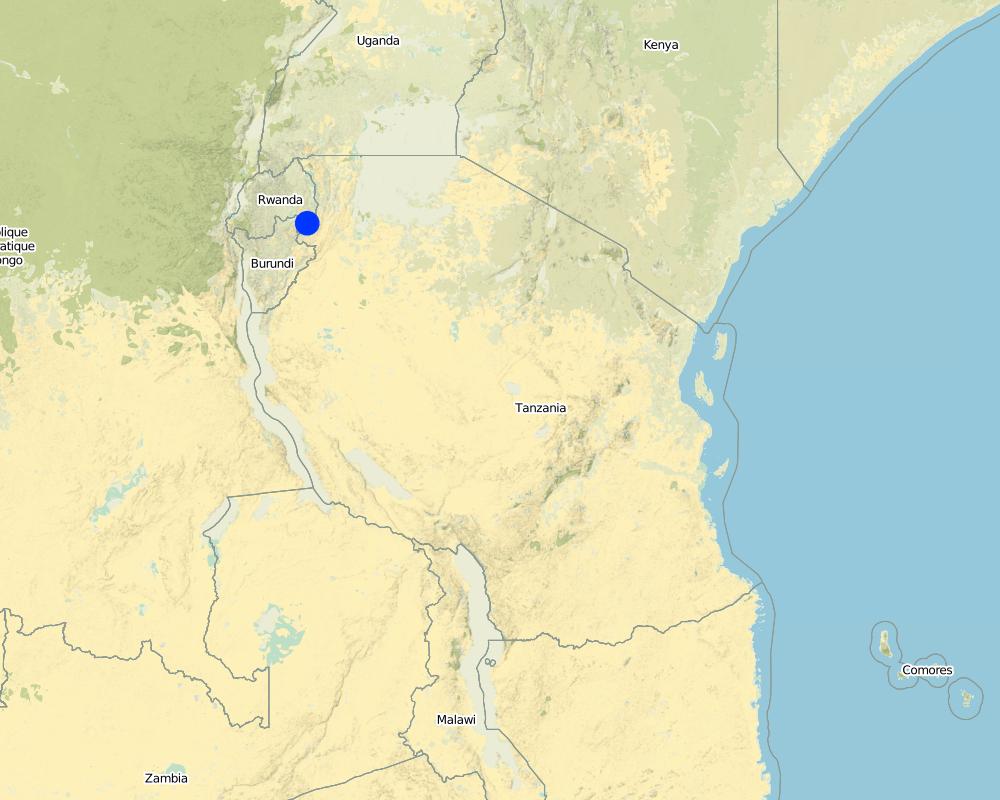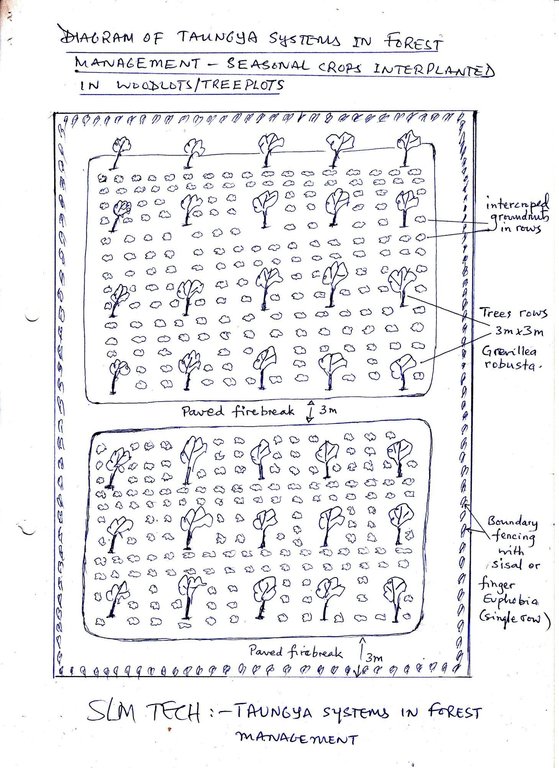Taungya systems for forest management [تنزانيا، جمهورية تنزانيا المتحدة]
- تاريخ الإنشاء:
- تحديث:
- جامع المعلومات: Philip Ileta
- المحرر: –
- المُراجع: David Streiff
Kilimo cha miti na mazao ya msimu (Swahili), Intercropping trees with annual crops
technologies_1156 - تنزانيا، جمهورية تنزانيا المتحدة
عرض الأقسام
توسيع الكل طي الكل1. معلومات عامة
1.2 تفاصيل الاتصال بالأشخاص الرئيسيين لمصدر المعلومات والمؤسسات المشاركة في تقييم وتوثيق التقنية
متخصص في الإدارة المستدامة للأراضي:
Mugishagwe Wilson
Ngara District Council
تنزانيا، جمهورية تنزانيا المتحدة
متخصص في الإدارة المستدامة للأراضي:
Waluce Michael
Ngara District Council
تنزانيا، جمهورية تنزانيا المتحدة
متخصص في الإدارة المستدامة للأراضي:
Sangatati Joesephat
Ngara District Council
تنزانيا، جمهورية تنزانيا المتحدة
متخصص في الإدارة المستدامة للأراضي:
Waziri Zawadi
Ngara District Council
تنزانيا، جمهورية تنزانيا المتحدة
اسم المؤسسة (المؤسسات) التي سهلت توثيق/تقييم التقنية (إذا كان ذلك على صلة)
Ngara District Council (Ngara District Council) - تنزانيا، جمهورية تنزانيا المتحدة1.3 الشروط المتعلقة باستخدام البيانات الموثقة من خلال WOCAT
متى تم تجميع البيانات (ميدانيا)؟:
12/12/2011
يوافق جامع المعلومات والشخص (لاشخاص) الرئيسي لمصدر المعلومات على الشروط المتعلقة باستخدام البيانات الموثقة من خلال WOCAT:
نعم
1.4 إعلان بشأن استدامة التقنية الموصوفة
هل التقنية الموصوفة هنا تمثل مشكلة فيما يتعلق بتدهور الأراضي، بحيث لا يمكن إعلانها تقنية مستدامة لإدارة الأراضي؟:
كلا
2. وصف تقنيةالإدارة المستدامي للأراضي
2.1 وصف مختصر للتقنية
تعريف التقنية:
A forest management system whereby trees are inter-cropped with annual crops until when the crops below can no longer flourish due to the dense canopy of trees.
2.2 وصف تفصيلي للتقنية
الوصف:
The overall purpose is to establish and manage forest in a sustainable manner. Land preparation is done during the dry season. Prepared seedling is planted at the beginning of the rainy season at recommended spacing. The area between trees is intercropped with selected annual crops. The crops can continue to be grown until the tree canopy covers the ground (3 to 4 years period). At this stage the system does not support intercropping and the trees are left to grow on their own. The Taungya technology is applied on degraded forest or a new established forest. Recomended supportive technologies are contours for erosion control and manure application for soil quality improvement.
Purpose of the Technology: A well established and managed forest/woodlot ensured in the degraded forest by:
-Intercropping with selected annual crops to improve soil cover, water infiltration, soil organic matter, reduce soil erosion and water evaporation.
-To conduct multiple tending operations for the tree plots and crops (weeding,firebreaks,pruning and thinning)thus minimizing the costs and maximizing returns
-Increased productivity and production through diversification strategies.
-Enhance food security and income.
Establishment / maintenance activities and inputs: -Land preparation during dry season (June to Sept).
-(Allignment,marking and pitting for tree seedlings (Oct-Nov)
-Planting of trees(Nov-Dec)
-Planting of crops (Oct-Nov)
-Weeding
-Harvesting crops
Natural / human environment: Fire threats during dry season, Termite attacks to trees, High costs for labour to perform tending activities in large forest plots
2.3 صور التقنية
2.5 البلد/المنطقة/المواقع التي تم تنفيذ التقنية فيها والتي يغطيها هذا التقييم
البلد:
تنزانيا، جمهورية تنزانيا المتحدة
المنطقة/الولاية/المحافظة:
Kagera
مزيد من التفاصيل حول الموقع:
Ngara
Map
×2.6 تاريخ التنفيذ
في حالة عدم معرفة السنة بالتحديد، يرجى الإشارة إلى التاريخ التقريبي:
- منذ أقل من 10 سنوات (مؤخرًا)
2.7 إدخال التقنية
حدد كيف تم إدخال التقنية:
- من خلال المشاريع/ التدخلات الخارجية
التعليقات (نوع المشروع، الخ):
Various projects of afforestation have been active in the area before and during the Refugee influx from Rwanda and Burundi 1994-2007
3. تصنيف تقنية الإدارة المستدامي للأراضي
3.1 الغرض الرئيسي ( الأغراض الرئيسية) للتقنية
- الحفاظ على النظام البيئي
- الحفاظ على/تحسين التنوع البيولوجي
3.2 نوع (أنواع) استخدام الأراضي الحالية حيث يتم تطبيق التقنية

الغابات/ الأراضي الحرجية
زراعة الأشجار، التشجير:
- أصناف مختلطة
منتجات وخدمات:
- الخشب
- حطب الوقود
- الرعي/ رعي أطراف الأشجار الفتية (الجلح)

مختلطة (محاصيل/ رعي/ أشجار)، بما في ذلك الحراجة الزراعية
- الحراجة الزراعية
المنتجات / الخدمات الرئيسية:
major cash crop: Timber trees
major food crop: Casava,beans and gnuts
التعليقات:
Major land use problems (compiler’s opinion): High fire incidences during dry seasons, Red clay loam soils harden and dry easily during dry spells, Forest are usually long term investments,thus high costs of inputs before harvests
Major land use problems (land users’ perception): High fire incidences during dry seasons, High costs for weeding and slashing
Problems / comments regarding forest use: Softwood plantation
Future (final) land use (after implementation of SLM Technology): Forests / woodlands: Fp: Plantations, afforestations
3.3 مزيد من المعلومات حول استخدام الأراضي
إمدادات المياه للأرض التي يتم تنفيذ التقنية عليها:
- بعلية
عدد مواسم الزراعة في السنة:
- 2
حدد:
Longest growing period in days: 120; Longest growing period from month to month: Oct to Dec; Second longest growing period in days: 90; Second longest growing period from month to month: March to May
3.4 مجموعةالإدارة المستدامة للأراضي التي تنتمي إليها هذه التقنية
- إدارة الغابات الطبيعية وشبه الطبيعية
- الحراجة الزراعية
3.5 انتشار التقنية
حدد انتشار التقنية:
- منتشرة بالتساوي على مساحة
إذا كانت التقنية منتشرة بالتساوي على منطقة ما، فحدد المنطقة التقريبية المغطاة:
- 0.1-1 كم2
التعليقات:
Total area covered by the SLM Technology is <0.1 km2.
The plantation is planted mainly with Pinus caribaea and few compartments Maesopsis eminii of 3 years and intercropped with cassava,gnuts and beans,well weeded and firebreaks established. The plantation covers 32 hectares
3.6 التدابير التقنية في مجال إلادارة المستدامة للأراضي

التدابير الزراعية
- A3: معالجة سطح التربة

التدابير النباتية
- V3: إزالة الغطاء النباتي

التدابير الإدارية
- M2: تغيير في مستوى الإدارة/الكثافة
3.7 الأنواع الرئيسية من تدهور الأراضي التي تناولتها التقنية

التدهور المادي أو الفيزيائي للتربة
- (Pk)ظهور وتكون قشرة سطحية
- انسداد مسام التربة
التعليقات:
Main causes of degradation: deforestation / removal of natural vegetation (incl. forest fires), change in temperature (Fires become more aggresive in hot dry season)
Secondary causes of degradation: soil management (To enhance infiltration of water to hard subsoil), over-exploitation of vegetation for domestic use (Acute shortage of fuelwood in the area)
3.8 منع أو حد أو عكس تدهور الأراضي
تحديد هدف التقنية فيما يتعلق بتدهور الأراضي:
- منع تدهور الأراضي
4. المواصفات الفنية، وأنشطة التنفيذ، والمدخلات، والتكاليف
4.1 الرسم الفني للتقنية
4.2 المواصفات الفنية/شروحات الرسم الفني
Diagram of Taungya system in forest management -seasonal crop inter planted in woodlots/tree plots.
Location: Rusumo village. Ngara District Council/Kagera/ Tanzania
Date: 15 May 2013
Technical knowledge required for field staff / advisors: moderate (Experience in agroforestry extension is usually enough to assist farmers)
Technical knowledge required for land users: moderate (A number of manuals provide guidance on afforestation projects)
Main technical functions: reduction of dry material (fuel for wildfires)
Secondary technical functions: improvement of surface structure (crusting, sealing), control of fires
Mixed cropping / intercropping
Material/ species: cassava cuttings
Quantity/ density: 500/ha
Remarks: between tree rows
Cover cropping
Material/ species: beans
Remarks: between tree rows
Retaining more vegetation cover
Material/ species: Plant tree seedlings
Quantity/ density: 1700/ha
Remarks: Line planting 2.5mx2.5m
Manure / compost / residues
Material/ species: crop residues in repeated seasond
Remarks: remain to decay in tree plots
Breaking crust / sealed surface
Material/ species: thorough land cultivation using hand hoes
Remarks: during initial land preparation
Breaking compacted topsoil
Material/ species: continuous cultivation and weeding -hoes
Remarks: enhance water infiltration
Aligned: -linear
Number of plants per (ha): 1700
Vertical interval between rows / strips / blocks (m): 2.5
Spacing between rows / strips / blocks (m): 2.5
Vertical interval within rows / strips / blocks (m): 2.5
Width within rows / strips / blocks (m): 2.5
Trees/ shrubs species: Pinus caribaea
Perennial crops species: cassava
Gradient along the rows / strips: 8%
Change of land use type: convertion of rweya(uncultivated grassland) to woodlot/forest plantation
Change of land use practices / intensity level: Perform agronomy practices for crops,sivicultural practices for trees
Layout change according to natural and human environment: increseased soil cover due to many planted trees and agricultural crops
Major change in timing of activities: plant trees at the start of long rains to maximise survival rates
Control / change of species composition: indigineous trees highly deforested, replaced with planted forest of high cormecial value
Other type of management: Establishing firelines/roads each year enables easy prevention/controll of wild fires
4.3 معلومات عامة بخصوص حساب المدخلات والتكاليف
عملة أخرى/ عملة وطنية (حدد):
Tanzania shilling
أشر إلى سعر الصرف من الدولار الأمريكي إلى العملة المحلية (إذا كان ذا صلة): 1 دولار أمريكي =:
1600,0
اذكر متوسط تكلفة أجر العمالة المستأجرة في اليوم الواحد:
1.25
4.4 أنشطة التأسيس
| النشاط | نوع التدبير | التوقيت | |
|---|---|---|---|
| 1. | Allign and screef 3m wide roads around tree plot and between compartments | إدارية | before dry season |
4.5 التكاليف والمدخلات اللازمة للتأسيس
| تحديد المدخلات | الوحدة | الكمية | التكاليف لكل وحدة | إجمالي التكاليف لكل مدخل | % من التكاليف التي يتحملها مستخدمو الأراضي | |
|---|---|---|---|---|---|---|
| العمالة | Allign and screef 3m wide roads around tree plot | persons/day/ha | 200,0 | 2000,0 | 400000,0 | 100,0 |
| معدات | Hoes, machetes and axes | pieces | 10,0 | 6000,0 | 60000,0 | 100,0 |
| المواد النباتية | Tree seedlings | pieces | 1700,0 | 200,0 | 340000,0 | 50,0 |
| المواد النباتية | Cassava cuttings | pieces | 5000,0 | 20,0 | 100000,0 | 100,0 |
| المواد النباتية | Beans | kg | 25,0 | 500,0 | 12500,0 | 100,0 |
| إجمالي تكاليف إنشاء التقنية | 912500,0 | |||||
4.6 الصيانة/الأنشطة المتكررة
| النشاط | نوع التدبير | التوقيت/الوتيرة | |
|---|---|---|---|
| 1. | Weeding | زراعية | routine twice sesonally |
| 2. | Slashing and screefing firebreaks | زراعية | once yearly |
| 3. | Prunning excess tree branches | نباتية | every 3 yrs |
| 4. | Slashing short grass and screef firebreak roads | إدارية | once yearly |
4.7 التكاليف والمدخلات اللازمة للصيانة/للأنشطة المتكررة (سنويًا)
| تحديد المدخلات | الوحدة | الكمية | التكاليف لكل وحدة | إجمالي التكاليف لكل مدخل | % من التكاليف التي يتحملها مستخدمو الأراضي | |
|---|---|---|---|---|---|---|
| العمالة | Weeding | persons/day/ha | 100,0 | 2000,0 | 200000,0 | 100,0 |
| العمالة | Slashing and screefing firebreaks | persons/day/ha | 50,0 | 2000,0 | 100000,0 | 100,0 |
| العمالة | Prunning excess tree branches | persons/day/ha | 5,0 | 4000,0 | 20000,0 | 100,0 |
| العمالة | Slashing short grass and screef firebreak roads | persons/day/ha | 10,0 | 2000,0 | 20000,0 | 100,0 |
| إجمالي تكاليف صيانة التقنية | 340000,0 | |||||
التعليقات:
Machinery/ tools: hoes, matchets, axes, slashers, handsaws, per hectare year (2012)
4.8 أهم العوامل المؤثرة على التكاليف
قدم وصفا لأهم العوامل التي تؤثر على التكاليف:
high labour especially during establishment and repeated tending of crops and trees
5. البيئة الطبيعية والبشرية
5.1 المناخ
هطول الأمطار السنوي
- < 250 مم
- 251- 500 ملم
- 501 - 750ملم
- 1,000-751 ملم
- 1,500-1,100 ملم
- 2,000-1,500 ملم
- 3,000-2,001 ملم
- 4,000-3,100 ملم
- > 4000 ملم
المنطقة المناخية الزراعية
- شبه رطبة
Thermal climate class: tropics
5.2 طوبوغرافيا
متوسط الانحدارات:
- مسطح (0-2%)
- بسيط (3-5%)
- معتدل (6-10%)
- متدحرج (11-15%)
- تلال (16-30%)
- شديدة الانحدار(31-60%)
- فائقة الانحدار (>60%)
التضاريس:
- هضاب/سهول
- أثلام مرتفعة
- المنحدرات الجبلية
- منحدرات التلال
- منحدرات في السفوح
- قاع الوادي
المنطقة الارتفاعية:
- 100-0 متر فوق سطح البحر
- 500-101 متر فوق سطح البحر
- 1,000-501 متر فوق سطح البحر
- 1,500-1,001 متر فوق سطح البحر
- 2,000-1,501 متر فوق سطح البحر
- 2,500-2,100 متر فوق سطح البحر
- 3,000-2,501 متر فوق سطح البحر
- 4,000-3,001 متر فوق سطح البحر
- > 4000 متر فوق سطح البحر
5.3 التربة
متوسط عمق التربة:
- ضحل جدًا (0-20 سم)
- ضحلة (21-50 سم)
- متوسطة العمق (51-80 سم)
- عميقة (81-120 سم)
- عميقة جدًا (> 120 سم)
قوام التربة (التربة السطحية):
- متوسط ( طميي، سلتي)
المواد العضوية في التربة السطحية:
- عالية (>3%)
- متوسطة (1-3%)
إذا كان متاحًا، قم بإرفاق وصف كامل للتربة أو تحديد المعلومات المتوفرة، على سبيل المثال نوع التربة، الرقم الهيدروجيني/ درجة حموضة التربة، قدرة التبادل الكاتيوني، النيتروجين، الملوحة وما إلى ذلك.
Soil fertility is medium - high
5.4 توافر المياه ونوعيتها
منسوب المياه الجوفية:
> 50 م
توافر المياه السطحية:
متوسط
نوعية المياه (غير المعالجة):
للاستخدام الزراعي فقط (الري)
تعليقات ومواصفات أخرى بشأن نوعية المياه وكميتها:
Ground water table: The plot is on top of the plateau/ridge
Availability of surface water: Is good when further away, because the permanent rivers Kagera and Ruvuvu are 2km below the plateau.
Water quality (untreated): Good because a gravity scheme supplies water to nearby areas 2kms, but for agriculture only because seasonal agriculture in the dry season in wetlands along the rivers.
5.6 خصائص مستخدمي الأراضي الذين يطبقون التقنية
التوجه السوقي لنظام الإنتاج:
- مختلط (كفاف/ تجاري)
- تجاري/سوق
الدخل من خارج المزرعة:
- >50% من إجمالي الدخل
المستوى النسبي للثروة:
- متوسط
- ثري
أفراداً أو مجموعات:
- فرد/أسرة معيشية
مستوى المكننة:
- عمل يدوي
الجنس:
- رجال
اذكر الخصائص الأخرى ذات الصلة لمستخدمي الأراضي:
Land users applying the Technology are mainly common / average land users
Difference in the involvement of women and men: labour works performed well by both men and women
Population density: 10-50 persons/km2
Annual population growth: 2% - 3%
10% of the land users are rich and own 30% of the land.
20% of the land users are average wealthy and own 40% of the land.
Off-farm income specification: The land user is a businessman and have good number of cattle,however there are many other tree plots in the village owned by other farmers
5.7 متوسط مساحة الأرض المملوكة أو المستأجرة من قبل مستخدمي الأراضي الذين يطبقون التقنية
- < 0.5 هكتارا
- 0.5 - 1 هكتار
- 1 -2 هكتار
- 2 - 5 هكتار
- 5 - 15 هكتار
- 15 - 50 هكتار
- 50 - 100هكتار
- 500-100 هكتار
- 1,000-500 هكتار
- 10,000-1,000 هكتار
- > 10,000 هكتار
هل يعتبر هذا نطاقًا صغيرًا أو متوسطًا أو واسعا (في إشارة إلى السياق المحلي)؟:
- على نطاق متوسط
التعليقات:
0.5-1 ha: Farmers in the village have many eucalyptus tree plots for firewood and poles,but now opening new land for planting pines Agroforestry practices widespread in banana cropping system in the village
15-50 ha for cropland
5.8 ملكية الأراضي، وحقوق استخدام الأراضي، وحقوق استخدام المياه
ملكية الارض:
- فردية، لا يوجد سند ملكية
حقوق استخدام الأراضي:
- فردي
حقوق استخدام المياه:
- فردي
التعليقات:
water free for agricultural use,minimum payments for domestic use
5.9 الوصول إلى الخدمات والبنية التحتية
الصحة:
- ضعيف
- معتدل
- جيد
التعليم:
- ضعيف
- معتدل
- جيد
المساعدة التقنية:
- ضعيف
- معتدل
- جيد
الأسواق:
- ضعيف
- معتدل
- جيد
الطاقة:
- ضعيف
- معتدل
- جيد
الطرق والنقل:
- ضعيف
- معتدل
- جيد
مياه الشرب وخدمات الصرف الصحي:
- ضعيف
- معتدل
- جيد
الخدمات المالية:
- ضعيف
- معتدل
- جيد
6. الآثار والتصريحات الختامية
6.1 الآثار التي أظهرتها التقنية في الموقع
الآثار الاجتماعية والاقتصادية
الإنتاج
إنتاج المحاصيل
التعليقات/ حدد:
Harvesting of crops
إنتاج الخشب
التعليقات/ حدد:
At rotation age 15-20 yrs
الدخل والتكاليف
النفقات على المدخلات الزراعية
التعليقات/ حدد:
Multiple tending operations (crops and trees)
آثار اجتماعية واقتصادية أخرى
liv
الآثار الاجتماعية والثقافية
الأمن الغذائي / الاكتفاء الذاتي
livelihood and human well-being
التعليقات/ حدد:
Increased income from agriculture crop sales improve food security availability of forest products decreased workload mainly for women-branches of trees and thinnings for firewood
الآثار الايكولوجية
التربة
غطاء التربة
تكون قشرة التربة السطحية/انسداد مسام التربة
التنوع البيولوجي: الغطاء النباتي، الحيوانات
الكتلة الحيوية/ طبقة الكربون فوق التربة
الحد من مخاطر المناخ والكوارث
خطر الحريق
6.2 الآثار التي أظهرتها التقنية خارج الموقع
الأضرار التي لحقت بحقول الجيران
التعليقات/ حدد:
As windbreaks
6.3 تعرض التقنية وحساسيتها لتغير المناخ التدريجي والظواهر المتطرفة/الكوارث المرتبطة بالمناخ (كما يراها مستخدمو الأراضي)
تغير مناخ تدريجي
تغير مناخ تدريجي
| الموسم | نوع التغير المناخي/ المتطرف | كيف تتعامل التقنية مع ذلك؟ | |
|---|---|---|---|
| درجة الحرارة السنوية | زيادة | ليس جيدا |
الظواهر المتطرفة / الكوارث المرتبطة بالمناخ
الكوارث المناخية
| كيف تتعامل التقنية مع ذلك؟ | |
|---|---|
| جفاف | ليس جيدا |
التعليقات:
The control of fires can be improved by boundary planting of fire tolerant plant species e.g sisal(Agaves sisalana),euphobia spp etc
6.4 تحليل التكلفة والعائد
كيف يمكن مقارنة العوائد نسبة لتكاليف الإنشاء (من وجهة نظر مستخدمي الأراضي)؟
عوائد قصيرة الأجل:
إيجابي
عوائد طويلة الأجل:
إيجابي
كيف تتم مقارنة العوائدمع كلفة الصيانة/التكاليف المتكررة (من وجهة نظر مستخدمي الأراضي)؟
عوائد قصيرة الأجل:
سلبي قليلا
عوائد طويلة الأجل:
إيجابي
التعليقات:
Benefits from timber harvest from18 yrs and above,but can harvest for pulp at 8yrs,short term benefits from trees include thinnings for firewood short term from crop sales, decreased input costs due to multiple tending
6.5 اعتماد التقنية
- أكثر من 50%
إذا كان متاحًا، قم بتحديد الكمية (عدد الأسر المعيشية و/أو المساحةالمغطاة):
24 households covering 100 percent of stated area
من بين جميع الذين تبنوا التقنية، كم عدد الذين فعلوا ذلك بشكل تلقائي، أي دون تلقي أي حوافز مادية/مدفوعات؟:
- 90-50%
التعليقات:
4 land user families have adopted the Technology with external material support
20 land user families have adopted the Technology without any external material support
Comments on spontaneous adoption: The planting of pine and intercropping with cassava,gnuts and beans has been adopted by many farmers due to the anticipation of carbon trading in future and expansion of cormecial forestry
There is a strong trend towards spontaneous adoption of the Technology
Comments on adoption trend: Large ares of land in Rusumo are still uncultivated/no settlements and many farmers have opted to establish woodlots of pines-as highly paying project in future with posibilities for accessing bank loans
6.7 نقاط القوة / المزايا / الفرص التي توفرها التقنية
| نقاط القوة/ المزايا/ الفرص من وجهة نظر مستخدمي الأراضي |
|---|
| Increased incomes |
| Diversified food crops |
| Fire outbreak prevention/control |
| نقاط القوة/ المزايا/ الفرص من وجهة نظر جامع المعلومات أو غيره من الاشخاص الرئيسيين لمصدر المعلومات |
|---|
| Production of timber and firewood |
| Enhanced food security |
| Prevention of fire to damage trees/crops |
| Reduce soil erosion-improved soil cover |
| Improved carbon sequestration |
6.8 نقاط ضعف / مساوىء / مخاطر التقنية وسبل التغلب عليها
| نقاط الضعف/ المساوىء/ المخاطر من وجهة نظر مستخدم الأراضي | كيف يمكن التغلب عليها؟ |
|---|---|
| High labour costs | grow food crops for 3-4 yrs |
| Shading increases and can no longer support crops | seek advise from agriculture/forestry depts prunnings, thinning on time |
| نقاط الضعف/ المساوىء/ المخاطر من وجهة نظر جامع المعلومات أو غيره من الاشخاص الرئيسيين لمصدر المعلومات | كيف يمكن التغلب عليها؟ |
|---|---|
| High labour costs | in places with shortage of lands renting farm plots |
| Difficult to use machines in tending,weeding etc | Timely prunning and thinning regimes |
| Shading increses and can no longer support crops | Keep dogs and seek support from Game control department |
| Can be hiding place for vermin |
7. المراجع والروابط
7.1 طرق جمع/مصادر المعلومات
- زيارات ميدانية، مسوحات ميدانية
- مقابلات مع مستخدمي الأراضي
الروابط والوحدات المواضيعية
توسيع الكل طي الكلالروابط
لا يوجد روابط
الوحدات المواضيعية
لا يوجد وحدات مواضيعية





